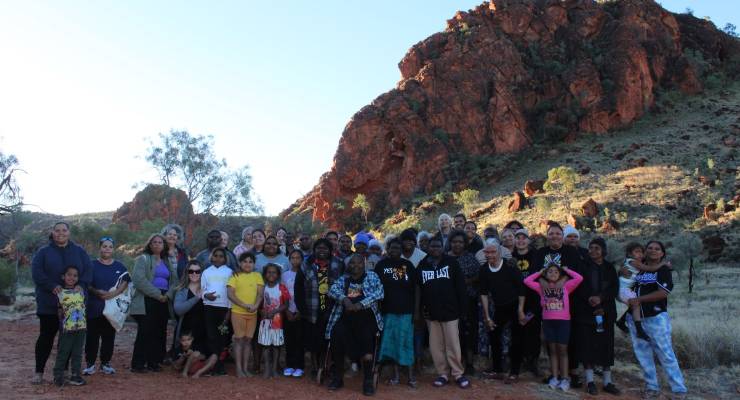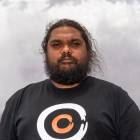
Aboriginal and Torres Strait Islander readers please note that this article mentions deceased persons.
First Nations educators from around the country launched a landmark report today calling for national reform of Australia’s education system. At its core is recognition and resourcing of a First Nations model of education called Apmerengentyele (Ap-mer- ung-n-jel-a), meaning “from the land”.
“The Steiner schools, the Montessori schools, the Catholics, the Lutherans — every other organisation in Australia has had an opportunity to develop a system. First Nations have not,” Gunggari woman Stacey Campton, director of First Nations education organisation Children’s Ground, tells Crikey and reporting partner Indigenous Community Television (ICTV).
“If we’re going to have a Voice to Parliament, if we’re going to get a referendum, then one of the biggest, boldest reforms that we would like to see come forward is the investment in a First Nations education system. Minister Burney has called for bold reforms. Well, here’s one for you.”
More than 50 First Nations educators are stationed at Ross River Resort, about 80km east of Mparntwe (Alice Springs), for day three of four of Utyerre Apanpe (oo-cherra a-parn-pa) — an annual Black-only First Nations education conference convened by Children’s Ground that’s doubling as the launch site of “The MK Turner Report”.
Named after the late Arrernte Elder, professor, artist, author, language speaker, teacher and founding director and cultural authority at Children’s Ground, Dr MK Turner OAM, the report is a policy document born out of four years of Utyerre Apanpe and input from more than 60 First Nations educators. It’s half a decade in the making and synthesises half a century of knowledge sharing, discussion, consensus and international evidence on the need (and right) for a standalone First Nations system of education.
Campton is clear: First Nations people do not want a First Nations “add-on or bolt-on” to the existing Western model of education. They want a “completely separate system” that acknowledges and privileges a First Nations way of thinking and learning.
In short, education led, designed, delivered and run by First Nations peoples for First Nations peoples, with language, culture and Country — not classrooms — at its core.
“It’s an entire system change to the status quo of having a classroom, a teacher, someone who doesn’t even understand who you are or even speak the language that you speak,” founding chair of Children’s Ground and 2023 Male Elder of the Year, Arrernte man William Tilmouth says.
The four-day conference is exclusive to First Nations peoples, but Crikey and ICTV have been given permission to attend and report on the diversity of First Nations voices calling for collective upheaval of the education system in person and on paper.
The report is clear: a Western model of education is not made for First Nations peoples.
As it stands, a migrant child in Australia is far more likely to learn in their first language at school than an Indigenous child. That’s despite international evidence from UNESCO in 2012 and the World Bank in 2021 (along with a long list of national reviews) that learning in first language and in First Nations ways improves not only education outcomes but also health, economic and social metrics for Indigenous peoples.
“The World Bank has basically caught up with what Dr MK Turner was saying 30 years ago,” CEO of Children’s Ground Jane Vadiveloo says. “There’s nothing new in this; it just hasn’t been done in Australia.”
Looking overseas, Aotearoa New Zealand and Hawaii have done it for more than 40 years. Back home, First Nations peoples have practised it for millennia and called for it since colonisation. In the ’70s there was a formal roll-out of bilingual First Nations education, but this was later gutted by funding cuts. Vadiveloo says “It’s time for a change” and Apmerengentyele is that change.
The report recommends that the Australian government commit to this standalone system and support a First Nations workforce to service it. Key to this is the establishment of First Nations language and literacy centres, as well as a national First Nations knowledge hub — the MK Turner Institute.
Tilmouth hopes the report will open the eyes of politicians, educational institutions and teachers across the nation to the power of a First Nations model of education. He wants them to read it, listen to it and then “do something about it”.
“This is not willy-nilly, pie-in-the-sky stuff. This is real. This is the reality of our existence and if we lose that it’s gone forever,” he says.
“No longer do we sit back and take prescribed solutions; no longer do we sit back and take the solutions of people who designed them who sit in Canberra, who know nothing about us.
“We have our solutions; we have our answers; we need to be heard. And that’s what Children’s Ground is all about, empowering people to have that voice to be able to speak up and do it their way.”










The thing that concerns me most is language. As a lawyer who has worked with indigenous lawyers from Australia and other Pacific countries, I can say that one of the greatest problems, if not actually the greatest, is the inability to read and write English with complete fluency. Fluency in English is essential for a lawyer and for most if not all other professions, as well as in business, retail and other occupations in a major city or any urban area. Knowledge of an indigenous language is no doubt highly beneficial in many ways, but if the children are hoping to make their way in an English-speaking world, they need complete fluency in English. Having English taught as a second language is not likely to produce this.
I believe many education systems that teach in minority kids’ own language only do so for the first few years. Obviously, there wouldn’t be teachers or textbooks for specialised subjects in a language with only a few thousand speakers.
Two things.
First, I would say that the more exposure the kids have to English, including at an early age, the better.
Secondly, I doubt that what you’re suggesting is feasible in remote locations.
I’m not suggesting it, I too see many difficulties. It’s what the article seems to be suggesting.
Totally agree the curriculum has to be written so that it will encourage talents in all walks of life, lawyers to actors, teachers, nurses and policeman. I respectfully suggest that somehow it must become a bolt on to the existing, not perfect system.
This is the way of todays the world, and complete fluency English will be a necessary pre requirement for future employment and growth prospects in but that is the way the world works,
Shut up and assimilate? That’s worked out real well for 230 years, hasn’t it?
It did at least until, post the 1967 referendum, the unemployable BA Soc/Lits extruded from free tertiary education began building their pissant empires.
Any language is useful for kids.. The problem with English only, or English first, is that it disengages students from Non English Speaking Backgrounds. Kids just hate school , which is fair enough since they cannot understand what’s going on.
I suspect that we’re missing the point and they’re aiming a lot higher than turning out more lawyers. The kids capable of that will always rise to the top. I think this model will pick up and inspire a whole heap of disengaged kids. I think that this inspiration is what we’ve been looking for – that it will solve the root cause behind the less than optimal health outcomes, the mental health issues, the high incarceration rates – all of these things have been reflecting something deeper going on. I am inspired and excited by the possibilities!
Wow! This is great reporting. More, more, more!
So I have some questions reading the documentation:
– is this learning model “easier” for indigenous students (to improve pass rates?), or is it just as rigorous across the broad spectrum of science and maths that modern students need to learn.
– if it is the latter, can it be open to non-indigenous students who may suit this alternative learning methodology? It could be an improvement for many underperforming students from a range of backgrounds.
– is there an underlying perception that cultural specific leaning is preferred? Should there be culturally specific education streams for all migrant group (there seems to be already, take islamic schools).
– finally, there are some specifics that I am a little uncomfortable with. The document states that school environments should respect “avoidance relationships (cultural laws based on kinship)” whereas I wouldn’t support an education system that reinforces separation of groups based off arbitrary lines (we already see in the US increasing practise of exclusion from business based of gender or race lines)
A word or warning for related educators i.e. be careful initiatives are not used to insert or implement suboptimal teaching, learning and assessment from elsewhere.
Allegedly a decade ago, east coast teachers working in remote WA indigenous communities were shocked to find they were compelled to use syllabi and content imported from and designed for US (forget which state, deep south?) to teach youth in prisons….
This is going to be an interesting experiment. It’s about time that the Anglo/European dominated education systems thought outside the box in terms of Aboriginal kids, particularly those from inland communities.
The reference to Montessori schools made in the article is relevant. Using registered teachers may be a challenge.
My children attended a Montessori primary and some years of secondary school. The curriculum approached subjects differently, for example, maths was very hands-on with special tools to teach the concepts. However, the curriculum delivered all the learning required for the different stages of school.
The process of developing and approving a curriculum to show it meets the national standard isn’t easy. This is well worth supporting for first Nations.
There are also ways of engaging additional language teachers with specialist skills, without full teacher training, as long as their special skills can be assessed. Teach For Australia has tackled this for most states including WA and the NT.